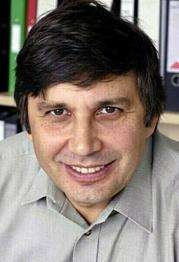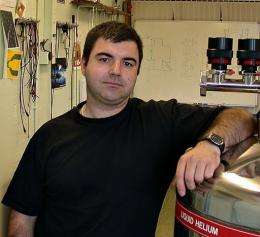Wonder carbon pioneers win Nobel Physics Prize (Update 4)

Two Russian-born scientists, Andre Geim and Konstantin Novoselov, won the 2010 Nobel Physics Prize Tuesday for pioneering work on graphene, touted as the wonder material of the 21st century.
Both laureates began their careers as physicists in Russia but now work at the University of Manchester in Britain. Geim holds Dutch nationality and Novoselov is both a British and Russian national.
The Royal Swedish Academy of Sciences hailed graphene, a form of carbon isolated only six years ago, for its glittering potential in computers, home gadgets and transport.
It lauded Geim, 51, and Novoselov, 36, for having "shown that carbon in such a flat form has exceptional properties that originate from the remarkable world of quantum physics."
Graphene is a novel form of carbon that comprises a single layer of atoms arranged in a honeycomb-shaped lattice.
Just one atom thick, graphene it is the world's thinnest and strongest nano-material, almost transparent and able to conduct electricity and heat.
As a result, graphene is described as the candidate material to replace silicon semi-conductors.
Graphene transistors would in theory be able to run at faster speeds and cope with higher temperatures than today's classic computer chips.
That would resolve a fast-growing problem facing chip engineers who want to boost power and shrink semiconductor size but without raising temperatures, the bugbear of computing.
Its transparency means it could potentially be used in touch screens and even solar cells, and when mixed with plastics would provide light but super-strong composite materials for next-generation satellites, planes and cars.
The academy said it was "interesting to consider that everyone who has used an ordinary pencil has probably produced graphene-like structures without knowing it."
The Nobel jury acknowledged that most of the practical applications of graphene "exist only in our fantasies, but many are already being tested."
Geim said last year as he accepted an honour at Britain's prestigious Royal Society that the list of uses was "long and (was) yet to be completed."
"Graphene has become known as a wonder material," he said.
-

Dutch scientist Andre Geim has been awarded the Nobel Physics Prize for pioneering work on graphene, a form of carbon which conducts electricity. Geim was a joint winner with Russian-British scientist Konstantin Novoselov. -

Professor Konstantin Novoselov was awarded the 2010 Nobel Physics Prize for pioneering work on graphene, a form of carbon which conducts electricity. Novoselov and fellow Russian-born scientist Andre Geim were jointly given the prize for their work on graphene, which the Nobel jury touted as the wonder material of the 21st century.
He also acknowledged at the time that he had spent his career jumping from one subject to another.
"Yes, it is hard to jump between subjects but it is worth the effort," he said, adding that "before graphene, there were other successes including gecko tape, mesiscopic superconductivity and levitating frogs."
His 1997 feat of making a frog levitate in a magnetic field was praised by the Nobel jury, who called it "an ingenious way of illustrating the principles of physics."
Gecko tape -- a super sticky tape inspired by the lizard's ability to stick to even the smoothest surfaces -- was meanwhile developed in 2003 by both Geim and Novoselov.
The latter began working for Geim as a PhD student in the Netherlands and at 36 is one of the youngest laureates of the Nobel Physics Prize.
He told the TT news agency he was "shocked" by the nod.
"This is just crazy," he said, adding that he had not been expecting the prize despite speculation that 2010 could be his year.
"I have learned not to listen to speculation," he said.
Geim told the committee he was looking at emails and looking at archives when he got the call.
"I slept well, I didn't expect the Nobel Prize this year," he said, adding he was going straight back to work.
He said that unlike one category of Nobel Prize winners, who "stop doing anything for the rest of their life," he belonged to a category of "people who think people think they won the Nobel Prize by accident so they start working even harder than before."
The University of Manchester said the award was "a wonderful example of a fundamental discovery based on scientific curiosity with major practical, social and economic benefits for society."
Geim and Novoselov will split 10 million Swedish kronor (1.49 million dollars, 1.09 million euros) in prize money and will receive a medal at a December 10 gala dinner in Stockholm.
Read more about this year's prize:
• Information for the Public
• Scientific Background (pdf)
Lattice to replace chips in computers to come
by Richard Ingham
For more than half a century, computers have been obeying "Moore's Law," a principle named after Gordon Moore, the co-founder of chip maker Intel.
Under it, the number of transistors that can be incorporated in a chip has doubled every 18 months or so, which explains the extraordinary rise in processing speed and memory capacity at the heart of modern gadgets.
The "law" was predicted by Moore to endure until the mid-1970s, yet it is still going strong -- but not for much longer.
As early as 2015, according to the gloomiest estimates, engineers working in silicon and other existing materials will run smack into another law: the limits of miniaturisation, when too many circuits cramped into too small a space leads to higher temperatures which in turn crimps efficiency.
This is why graphene, the material that on Tuesday unlocked the Nobel Prize for Russian-born physicists Andre Geim, 51, and Konstantin Novoselov, 36, has been greeted with such excitement.
Graphene is a novel form of carbon that comprises a single layer of atoms arranged in a honeycomb-shaped lattice.
Even though the substance is chemically very simple, it is a stellar performer in strength, in conducting electricity and dissipating heat.
That makes it a fabulous candidate to replace semiconductor chips -- and explains why microchip giants such as IBM and Intel have been investing heavily in a material that today only exists in tiny flakes.
"Diamonds may be a girl's best friend but graphene gives an unexpected and a wholly new way to put the electron in carbon country," said Marshall Stoneham, president of the Institute of Physics in London.
Graphene transistors would in theory run at far higher speeds and cope with much higher temperatures than silicon counterparts.
As graphene is nearly transparent, it would also be suitable for making touch screens, light panels and possible solar cells.
Plastics with graphene added to them can become heat-resistant and -- thanks to the robustness of the carbon lattice -- mechanically strong. They could be incorporated as composite materials in the satellites, planes and high-performance cars of the future.
"Graphene has become known as a wonder material," Geim, a professor at the University of Manchester, northwestern England, said last year as he accepted an honour at Britain's prestigious Royal Society.
"Not only is it the thinnest material in the Universe, but also the strongest ever measured. It can sustain current densities a million times higher than that of copper, shows record thermal conductivity and stiffness and allows the investigation of quantum relativistic phenomena in a bench-top experiment.
"The full list is long and is yet to be completed."
Graphene was aired as a theoretical substance in 1947, but for decades, many physicists thought it would be impossible to isolate, suggesting that such thin crystalline sheets were bound to be unstable.
Showing smartness and arguably the cheapest technology around, Geim and Novoselov in 2004 extracted graphene by painstakingly using ordinary sticky tape to pick up a flake from a piece of graphite -- the carbon form found in pencils.
Graphene still remains firmly a laboratory substance, produced only in flakes of a fraction of a millimetre, which of course is far too small to be useable in electronics.
But in January this year, European scientists demonstrated how graphene production could be scaled up by "growing" one layer on another on silicon carbide.
Nobel Physics laureates shocked at prize win
Russian-born scientists Andre Geim and Konstantin Novoselov both admitted Tuesday they were taken by surprise at winning the Nobel Physics Prize for their work on graphene.
"I am shocked," Novoselov, a 36-year-old Russian-British national, told the TT newswire which said it was first to inform, him of the award.
"This is just crazy," he said, adding that he had not been expecting the prize despite speculation that 2010 could be his year.
"I have learned not to listen to speculations."
Geim, 51, who was born in Russia but is a Dutch national, said he was also taken by surprise.
According to the Nobel Prize Committee's official Twitter page, Geim said he was answering emails and was looking at archives when he received the call Tuesday.
"I slept well. I didn't expect the Nobel Prize this year," he said in a call-in press conference broadcast on Swedish public television just after the prize was announced.
He said he planned to get straight back to work.
"In my opinion there are several categories of Nobel Prize winners, one which after getting the Nobel Prize stop doing anything for the rest of their life. It is a big disservice for the community," he said.
The other category of people, which he said he belonged to, were "people who think people think they won the Nobel Prize by accident so they start working even harder than before."
(c) 2010 AFP




















